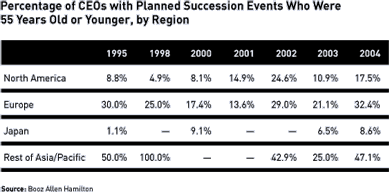CEO Succession 2004: The World’s Most Prominent Temp Workers
With forced turnover up 300 percent since 1995, business has entered the era of the short-term chief.
 |
|
Photograph by Chris Callis |
The answer, as Booz Allen Hamilton’s annual study of CEO succession at the world’s 2,500 largest companies shows, is that we are past that tipping point — not just in North America, but even more dramatically in Europe and Asia. More than 14 percent of the CEOs of these corporations left office in 2004. Of that group of departing CEOs, nearly a third — 111 individuals, representing 4.4 percent of the total chief executive population — were forced from office for performance-related reasons or because of disagreements with their boards. This is the highest level of forced resignations we have seen. It represents a 300 percent increase over 1995, the earliest year we benchmarked. In short, four years after our first CEO succession study concluded that early departure of chief executives is the “new normal” for corporations, the age of the ephemeral CEO is here.
The trend is undeniable, and the implications profound. Dissatisfied large shareholders and other corporate constituents have wrested power from imperial chief executive officers in all the world’s major economies. This is a natural response to today’s difficult corporate environment — continued pressure for investment returns, geopolitical uncertainties, expanded regulatory oversight, and international talent wars — along with the perceived or real inability of many CEOs to deliver. Chief executives thus are being treated more in the manner to which other executives and middle managers have long become accustomed: Hit your numbers or hit the road. Endanger or embarrass the company, and you’re history.
This shift was evident in North America even before the turn of the millennium. In Europe and Asia, by contrast, the shift is relatively new. Rates of forced departures and total turnover of CEOs are speeding up. In 2004, the probability that a CEO would be fired was nearly twice as high in Europe as in North America.
The continuing insecurity of chief executives raises many troubling questions about the conduct of business. Has the shareholder activism movement gone too far? Is the imperative to “deliver or depart” leading CEOs to focus more on short-term tactics than long-term strategy? But even as policymakers and executives grapple with the answers, this transformation in company leadership means that would-be chief executives today require skill sets strikingly different from those needed by CEOs in the past. And it means that boards and management together need to adapt their organizations and processes to an environment where executive leadership is no longer dominant by default.
“The power has shifted,” says Eleanor Bloxham, president of the Corporate Governance Alliance, which advises companies and investors on board–management relationships. “Directors are telling me that, once they get used to it, they think this new level of scrutiny of the CEO is good. They like their strategic involvement, and they intend to keep it.”
Among the specific findings for 2004:
• Underperformance — not ethics, not illegality, not power struggles — is the primary reason CEOs get fired. Forced turnovers are strongly correlated with poor shareholder returns. During the year before they left, dismissed CEOs had generated median regionally adjusted returns that were 7.7 percentage points lower than those who left office under normal conditions.
• New chief executives hired from the outside inherit companies in much worse shape than those inherited by insiders. For the CEO “class” of 2004, outsider CEOs began their tenures at companies whose performance, in the form of shareholder returns, was 5.2 percentage points lower during the preceding year than the performance of companies that promoted insiders.
• The CEO’s job is stressing even its hardiest denizens. An increasing proportion of successful chief executives age 55 or younger, especially in North America, are choosing to retire.
• The Sarbanes-Oxley Act (SOX) of 2002 did not force more CEO turnover in the U.S. The upward shift in CEO firings occurred from 1995 to 2000; subsequent rates of overall turnover, dismissals, and tenure are all consistent with pre-SOX trends.
• Europe and Asia (excluding Japan) have become the most demanding environments for CEOs. These regions have the highest overall turnover, the most firings, the shortest tenures, and the most rapidly increasing rates of turnover.
• The former CEO can be a real drag. Companies in which a retired chief executive stays on as chairman are more likely to underperform other firms.
• Successful companies are more likely to fire a new CEO. Contrary to conventional wisdom, companies that performed well during the two years prior to their CEO’s appointment have been one-third more likely to force that new CEO from office. Companies that struggled before their new CEOs came in were more likely to keep them longer.
Dissatisfied Shareholders
Booz Allen studies CEO succession at the world’s largest companies to identify patterns in the relationship between the tenures of chief executives and the performance of their companies. Following the methodology used in previous years, we identified the chief executives at the 2,500 largest publicly traded companies in the world (based on market capitalization as of January 1, 2004) who left their positions during 2004. Using the companies’ public statements, as well as our review of press coverage, we determined whether a succession was voluntary or induced. (See “Methodology” at the end of this article.)
We used public data sources to help analyze these executives’ entire tenure as CEO, including personal demographic data (such as age at ascension and departure) and financial performance of their companies. In assessing performance over the CEO’s tenure, we measured total shareholder returns (TSR), including both stock price appreciation and dividends, and compared each individual company’s performance with the performance of a broad stock market index for the geographic region. Thus, our study reviewed the entire careers of CEOs at the point of their departures. We looked at such additional factors as whether the CEO was also chairman of the board, and whether he or she had previously served as CEO of another public company.
This year, we have expanded our data set to include the financial performance of companies in the years before each CEO assumed office. Our goal is to learn more about the circumstances under which boards turn to outsiders or insiders to run a company, and to understand more about the relationship between leadership characteristics and performance improvement in firms.
In our terminology, “regular” departures are all planned and long-scheduled retirements, as well as deaths. In 2004, regular departures occurred at a higher rate than ever before: 7.3 percent of the top 2,500 corporations. “Performance-related” departures are those in which the CEO was forced to resign, either because of poor performance or disagreements with the board. These too were higher than ever. The third category is “merger-driven,” when a CEO leaves after his or her company is acquired by or combined with another. At 2.4 percent, this was the only category to fall below its historical peak. (See Exhibit 1.)
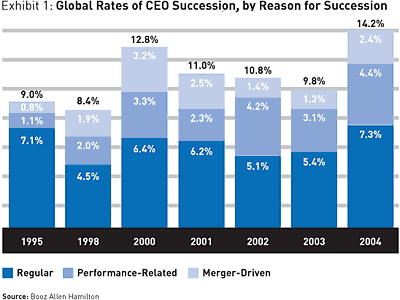
The results of our survey are highly relevant to the continuing debate about corporate governance. Notwithstanding such visible scandal-driven departures as those of Calisto Tanzi from Parmalat and Franklin Raines from Fannie Mae, the compliance problems and regulatory investigations of the past few years have directly forced comparatively few CEO resignations. Indirectly, however, ethical problems have had an effect. Shareholders are not just intolerant of sustained subpar investor returns. They are also increasingly intolerant of accounting shenanigans that disguise poor performance and artificially inflate profits. Legislators, regulators, and boards of directors around the world are helping shareholders root out questionable practices within companies, further increasing demands on company leaders.
Global Divergence
The shareholder activism we see reflected in CEO succession data is global in scope: Both total turnover and forced turnover are now greater in Europe and Asia than in North America. But the activism has very different implications for CEO turnover in each region of the world, reflecting differences in governance structures, history, and economics. (See Exhibit 2.)
Performance-related turnover of European CEOs reached record intensity in 2004, the highest level of forced turnovers in any region in any of the years we have studied. Total CEO turnover in Europe and Japan — 16.8 and 15.6 percent, respectively — also set new highs in 2004, nearly equaling the extraordinary 18 percent rate of turnover in North America following the dot-com crash in 2000. Just a few years ago, U.S. companies were the most likely to summarily fire their chief executive for poor performance. But over the last two years, European companies have begun to dismiss CEOs at a significantly higher rate: In 2004, 42 percent of CEO successions at European companies were related to performance, compared with 31 percent in the U.S. Turnover in Germany reached the highest levels we’ve seen in any major economy in any year of our survey, except for the U.K in 2000. Just a few examples: Ulrich Schumacher, founding chief executive of the Munich semiconductor manufacturer Infineon Technologies, was dismissed after five years at the helm; Wolfgang Urban resigned from retailer Karstadt Quelle after a three-year tenure; and Udo Stark stepped down after less than two years as CEO of the engineering corporation MG Technologies. (See Exhibit 3.)
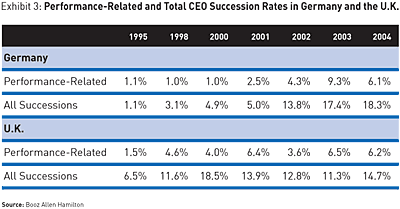
Recent governance reforms instituted in many European countries (such as the Tabaksblat Commission code in the Netherlands and the Higgs Report recommendations in the U.K.) offer part of the explanation. They have led many boards to become more proactive about risk management, and therefore quicker to depose a CEO whom they perceive as a potential liability. Shareholders are joining with supervisory boards, unions, and politicians in subjecting CEOs to far greater scrutiny than they received a few years ago.
European CEOs also face such challenges as the slow growth rate of the major European economies, their international exposure, and the limited opportunity in Europe to quickly drive up share prices through layoffs and restructuring. When global capital flows bump up against local or multiregional operations, it appears that the chief executive increasingly pays the price. Our colleague Klaus-Peter Gushurst, managing partner of Booz Allen Hamilton for Germany, suggests one other factor: a new generation of executives, in their 40s and 50s, coming to the fore with less support from their boards than their predecessors had.
The Asia/Pacific region (excluding Japan) exhibits even greater CEO turnover than Europe, although involuntary turnover is lower. Australia, which represents 18 percent of the large companies in the region, experienced exceptionally high turnover — 18.3 percent. This figure included many forced successions (36 percent of all succession events) and the retirement of two long-reigning CEOs, at Mirvac Groups (Bob Hamilton, 32 years) and Fosters (Ted Kunkel, 12 years).
In Japan, both performance-related and merger-driven turnover increased in 2004, a finding consistent with the hypothesis we offered two years ago that Japan is gradually making a transition to a Western-style governance model. At the same time, turnover rates in Japan are skewed by the traditional system for selecting CEOs, which emphasizes the long-term development of internal candidates who assume office at an advanced age (averaging 59.4 years in 2004), with only a limited time remaining until retirement. Even successful CEOs in Japan served an average of only 6.3 years, only slightly longer than the 5.2 years of unsuccessful North American CEOs.
In North America, CEO turnover in 2004 was consistent with the hypothesis that we advanced in two previous CEO studies: Turnover is stable, with planned successions and performance-related dismissals fluctuating around an annual average of 6 percent and 4 percent, respectively. Merger-related turnover is cyclical: In 2004, it stood at 2.8 percent, near the average we’ve seen across all years of our study. We expect it to increase, though. So far in 2005, major deals, such as Procter & Gamble’s purchase of Gillette, have propelled the value of mergers and acquisitions to their highest levels since late 2000, according to Bloomberg Business News.
The Sarbanes-Oxley Act isn’t yet affecting CEO turnover in the United States. Boards of directors in North America had already become more interventionist prior to SOX’s passage. The major governance changes imposed by the law, such as more independent directors and more power for board members and committees, may already be reflected in boardroom practice. We probably won’t be able to meaningfully assess SOX’s impact for another two years at least, when the first wave of poorly performing CEOs selected after the law’s enactment are forced from office.
Healthy Turnover Rates
As more chief executives retire prematurely or are pushed from office, one question arises: Are CEOs being scapegoated to such an extent that it is economically harmful?
One benchmark for CEO turnover is the normal attrition rate for all employees. According to quarterly surveys by the research publisher BNA Inc., the typical employee turnover rate in the United States is about 12 percent per year (excluding layoffs and temporary employees). The total rate of CEO turnover in 2004 is comparable to this overall rate of employee turnover, with the U.S. near the low end of the range and Europe near the high end. At least from the perspective of turnover, the CEO is just another employee.
As the demise of lifetime employment increases job-hopping among employees, more performance-related turnover of CEOs is increasing the rate of “CEO-hopping.” Thirteen percent of the CEOs who left office in 2004 had previously served as the CEO of a publicly traded corporation (either a different one or the same one), by far the highest rate in the seven years we’ve studied. CEO-hopping takes a variety of forms. Sometimes a current CEO is hired away, as Hewlett-Packard hired Mark Hurd from NCR. Sometimes a CEO who has left one company is hired by another, as was the case when Snap-on Inc. hired Jack Michaels, former CEO of the furniture company HNI. Sometimes a former CEO becomes the CEO again, as Charles Schwab reacquired the CEO title of the company that bears his name. There probably will always be loyal employees who get gold watches after 50 years of service, as there probably will be chief executives who rule with iron fists for decades. But there are likely to be fewer and fewer in each category.
The similarity between total employee turnover and CEO turnover implies a duality in the CEO’s job. On the one hand, the CEO is seen as “the boss,” setting the company’s direction, making the most important decisions, and hiring and firing people at all levels. And the CEO personifies the company, leading the company’s culture and serving as the spokesperson to stakeholder constituencies. But on the other hand, the CEO role is increasingly seen as an employee position, however highly compensated, visible, and strategically focused it may be. As long as the board resists the temptation to tinker with managerial decisions and to undermine the authority of the CEO, the duality needn’t be any more of a problem than that faced by a politician: supreme while in office but subject to removal at the next election.
One effective benchmark for CEO turnover is tenure — the amount of time that a departing CEO served in that position. Mean tenure varied a great deal by region in 2004, from less than five years in non-Japanese Asia to almost nine years in North America. (See Exhibit 4.) What then constitutes an appropriate CEO tenure, indicating a generally healthy economy?
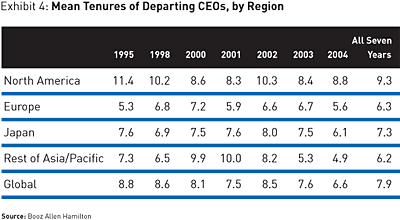
Globally, in 2004, underperforming CEOs were removed after an average of 4.5 years. In our judgment, this is an appropriate amount of time. In today’s rapidly changing economy, successful strategies have to produce positive results within five years. A 15-year vision is irrelevant. On the other hand, research tells us that CEOs need three to five years to develop their strategies and see them through to their results. CEOs on a short leash tend to become more risk averse and may be reluctant to embark on riskier projects, such as big investments or M&A activity. This may actually hurt sustainable corporate value growth.
In Europe in particular, the pendulum may already have swung too far toward the short term. In 2004, CEOs removed for poor performance were in office for a median tenure of two and a half years, an astonishingly and counterproductively brief period of time. Many of the fundamental changes needed to make companies competitive require more than two years to take effect, especially given the region’s tradition of cooperative labor relations and the high social costs associated with transformative change. Europe may be entering a cycle in which transformative change is required but the threat of rapid dismissal focuses existing CEOs on short-term performance, preventing them from completing (or even launching) the transformations that many European companies need.
In contrast, by global standards, CEO turnover in North America is too low. Boards in North America are the slowest to remove underperforming CEOs: The 5.2 years the average underperforming American chief gets is significantly longer than the span in any other region of the world. The rate of performance-related successions in North America is also low: 3.6 percent of American CEOs were fired in 2004, compared with the global average of 4.4 percent. We estimate that the 9.5 percent of North American CEOs departing between 2000 and 2004 whose companies underperformed the stock market should have been removed much more quickly by their boards; the Michael Eisner soap opera is by no means an isolated case. Our estimate reflects CEOs who underperformed the stock market not only during their full tenure, but also during the second half of their tenure, and whose total tenure exceeded the global average. Shareholders would have been better off if these CEOs had been removed at the midpoint of their tenure.
The principal driver of the long mean North American tenure is the extraordinary proportion of CEOs who stay in office at least 20 years — three times as many long-service CEOs as in Europe and nearly twice as many as in Japan and the rest of the world. This phenomenon reflects, in part, the strengths of the North American economy: Half the long-serving CEOs are founding entrepreneurs in the mold of Dell Inc.’s Michael Dell, who relinquished the chief’s job to Kevin Rollins in 2004 after two decades; another quarter are visionary CEOs who transformed and renewed major corporations, such as August Busch III, who succeeded his father as head of Anheuser Busch Companies 30 years ago.
Long-serving North American CEOs generally deliver extraordinary performance: Seventy-eight percent of them delivered above-average returns to investors over their full tenure. However, only two-thirds also delivered superior returns during the last half of their tenure.
Investors don’t want boards to limit the tenure of the extraordinary performers. The challenge for boards of directors in North America is better management of the variance in CEO performance. They need to embrace extraordinary performers who remain in office for extended periods; to limit average performers to terms similar to the seven years typical in the rest of the world; and to replace substandard performers after a shorter period — like the global average of four and a half years.
Deceptive Remedies
Governance activists in the United States recommend separation of the roles of chairman and CEO in order to enhance the independence of the board and to improve the CEO’s accountability. These roles are already separated by law in much of Europe. Among the reasons given is avoidance of “the recurrence of massive destruction of investor value,” as separatists Ira M. Millstein and Paul W. MacAvoy put it in The Recurrent Crisis in Corporate Governance (Palgrave Macmillan, 2004).
However, the data in our study suggests, as noted last year, that separation of the roles of chairman and CEO generally reduces returns to investors. For example, in North America, CEOs who are chairmen deliver annual returns to shareholders 2.6 percentage points higher than CEOs who never receive the chairman title.
We find that when the former chief executive stays on as chairman, making the new CEO, in effect, an “apprentice” to a predecessor — a common occurrence when boards want to nurture a new CEO or ease the departure of a long-standing leader — results for investors are generally worse than if the roles remain combined. Over the entire seven years of successions in our study, “apprentice CEOs” (those who weren’t also the chairman at the outset of their tenures) posted lower median regionally adjusted shareholder returns than their counterparts who reported to a chairman, but who weren’t “apprentices” — in other words, whose chairman had never been the CEO of the same company. The difference in returns was 4.7 percentage points per year in North America, 3.0 points per year in Europe, and 2.6 points per year in Japan.
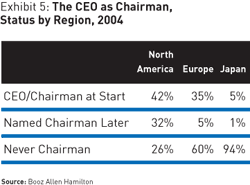 Japan, Europe, and North America differ significantly in whether the roles of chairman and CEO are combined, with Japan anchoring one extreme — 94 percent of CEOs were never chairman — and North America at the other extreme. (See Exhibit 5.) Europe’s position in the middle reflects its varied governance models. Some countries legally mandate separate executive boards and supervisory boards; others do not.
Japan, Europe, and North America differ significantly in whether the roles of chairman and CEO are combined, with Japan anchoring one extreme — 94 percent of CEOs were never chairman — and North America at the other extreme. (See Exhibit 5.) Europe’s position in the middle reflects its varied governance models. Some countries legally mandate separate executive boards and supervisory boards; others do not.
As governance activists expect, separation of the roles of chairman and CEO increases the likelihood that underperforming CEOs will be removed from office, shortening CEO tenure. We see this effect of greater board independence across all geographic regions, although the rarity of forced successions in Japan may obscure the relationship. (See Exhibit 6.)
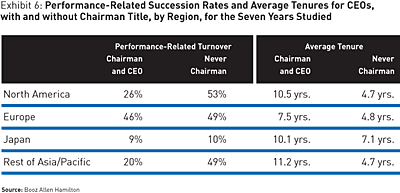
Shareholders generally do better when the chairman at the start of a new CEO’s tenure has not been the CEO of that company before. (See Exhibit 7.) In today’s hypercompetitive environment, the continuity provided by a chairman who was previously the CEO may be less important than the opportunity for a new CEO to chart a different course more appropriate for the future. In North America, an outsider is least likely to be brought in to effect change when the chairman is the prior CEO.
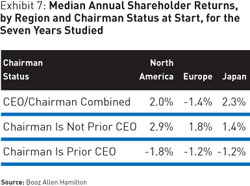 Two other factors further inhibit the effectiveness of companies at which the chairman was previously the CEO. First, operations or finance executives, who may have been excellent supporters of the previous CEO but who may not have the requisite strategic skills, are more likely to gain the top job when their former CEO remains chairman. Second, a new CEO who runs into initial problems is especially likely to be replaced if the former CEO remains the chairman — typically with the chairman reassuming the title of CEO. For example, in North America in 2004, four CEOs in office less than 18 months were deposed by boards chaired by the prior CEO: William Leonard (Aramark), David Pottruck (Charles Schwab & Co.), Frank Halliwell (CP Ships), and Roger Holstein (WebMD).
Two other factors further inhibit the effectiveness of companies at which the chairman was previously the CEO. First, operations or finance executives, who may have been excellent supporters of the previous CEO but who may not have the requisite strategic skills, are more likely to gain the top job when their former CEO remains chairman. Second, a new CEO who runs into initial problems is especially likely to be replaced if the former CEO remains the chairman — typically with the chairman reassuming the title of CEO. For example, in North America in 2004, four CEOs in office less than 18 months were deposed by boards chaired by the prior CEO: William Leonard (Aramark), David Pottruck (Charles Schwab & Co.), Frank Halliwell (CP Ships), and Roger Holstein (WebMD).
Corporate Strength
The questions that readers asked most frequently about previous surveys were: How much does CEO performance depend on the quality of the company? Are some companies so weak that no CEO can succeed? Are other companies so strong that most CEOs would be effective? To answer these questions, we expanded our data collection this year to include the performance of each company — the return to investors relative to the average return of the stock market in that region — before the CEO took office.
We found that a CEO’s performance in office is in fact influenced by the company’s previous performance. When a company has been doing poorly, a new CEO tends to perform very well in the first two years and badly in the last year. When a company has been performing well, a new CEO starts weak but ends stronger.
Our results are quite different from what our readers told us to expect, which was that CEOs generally perform better in companies that are doing well, especially in companies that are already great. Our conclusion results from our equating performance with returns to investors. Had we defined performance in terms of financial-statement measures, such as return on equity or cash-flow return on investment, we would undoubtedly have found a great deal of stickiness: A CEO’s performance would be closely related to the company’s prior performance. Returns to investors, however, reflect changes in a company’s financial performance, not the level of its performance.
We focus on returns to investors rather than financial-statement measures of performance because returns are the way the company’s owners — its investors — measure performance. Since boards of directors represent the company’s owners, returns to investors should be closely related to CEO tenure and involuntary departures.
Our results indicate that:
• CEOs are slightly more successful at improving the performance of poorly performing companies — whether by restructuring or by imposing greater executional discipline — than they are at improving the performance of companies that already perform well.
• Rapid improvement in financial performance is easiest to achieve in poorly performing companies.
• In poorly performing companies, it’s difficult to change the culture and sustain that higher level of financial performance. Performance often deteriorates, reverting to its previous level.
We also found that CEOs are more likely to be forced out of office at companies that had previously performed well than at companies that had been performing poorly. We hypothesize that in successful companies, the board of directors has very high expectations for the performance of a new CEO — and if the expectations aren’t met, the CEO is asked to leave. The lower expectations in a company that has been performing poorly are much easier for a new CEO to meet or exceed.
Insider Vs. Outsider
Over their entire tenures, CEOs appointed from the inside tend to outperform outsiders. Globally, over the seven years we have studied, insiders delivered returns to shareholders that were 1.9 percentage points per year higher than those delivered by outsiders. In 2004, insider CEOs in Europe outperformed outsider CEOs by 6.0 percentage points. In North America, however, outsiders outperformed insiders in 2004 for the first time since 1995. (See Exhibit 8.)
All CEOs experience a second-semester slump, but the depression is more pronounced among outsiders. For all seven years of our research, outsider CEOs produced returns 5.1 points higher than insiders during the first half of their tenures, but in the second half, insiders outperformed outsiders by 4.7 points. (See Exhibit 9.)
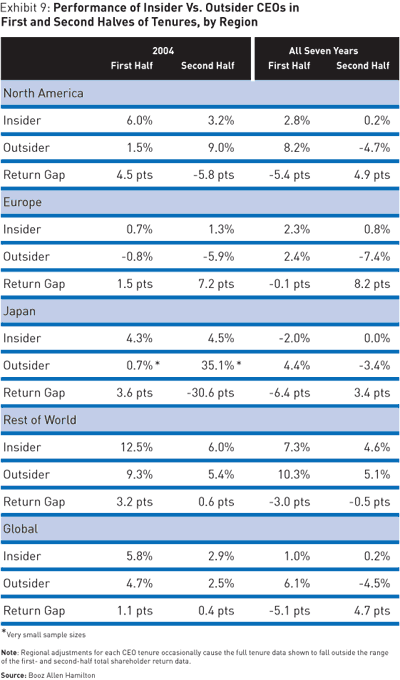
It is possible that outsiders are closing the gap, at least in North America, where in 2004, for the second year in a row, outsiders outperformed insiders in the second half of their tenures (by 5.8 points). European insiders leaving office in 2004 outperformed outsiders in both the first and second halves of their tenures, as they have for most of the other succession years tracked. For all seven years studied, European insiders had about the same performance as outsiders in the first half of their tenures, but outperformed outsiders by 8.2 points in the second half.
Globally, outsider CEOs inherit companies in much worse shape than insiders do. For CEOs leaving office in 2004, those who were outsiders when beginning their tenures took over companies whose performance was 5.2 percentage points lower during the preceding year than that of those companies taken over by insiders. Particularly in North America, and in Europe to a lesser extent, inside candidates were more likely to become CEO of companies that had been doing well, whereas outsiders were more prevalent at companies that had been performing poorly. This makes perfect sense: Outsiders are generally perceived to be better prepared to make the fundamental changes in direction required; outsiders may bring the skills or the fresh vision the company needs, and because of the company’s poor performance, the board may be skeptical of the capabilities of internal candidates.
Dread and Hope
“A man awaits his end, dreading and hoping all,” wrote the Irish poet William Butler Yeats. Certainly, for contemporary chief executives facing tenures that are increasingly short and increasingly likely to end in a dismissal, there is more than enough dread to go around.
But our research shows that there also is hope, and we would like to offer some guidance to CEOs and the boards that hire them:
• Work on your timing. Many boards of directors continue to do a bad job of replacing underperforming CEOs. Boards in Europe seem to be wielding the ax too quickly, whereas those in North America are not acting quickly enough. The persistent global trend of CEOs delivering inferior returns during the second half of their tenures shows that one of the main shortcomings of boards is their inability either to ease out underperformers at the right time — or, more importantly, to aid them when they need help.
• Strengthen succession planning. Boards — and CEOs themselves — are still not grooming future candidates for the chief executive position effectively, as evidenced by the increasing proclivity to hire outsiders and former chief executives of other companies, despite little long-term evidence that these candidates will perform better as CEOs. Our colleague DeAnne Aguirre, a senior vice president in Booz Allen Hamilton’s San Francisco office, observes that the pressure on CEOs to deliver results is causing many to fail to mentor and develop future leaders. “The whole philosophy of success through the success of others,” she notes, “seems to have been forgotten.” The expertise of McDonald’s, which lost two CEOs to untimely deaths during one year, is instructive: The fast-food company had candidates at the ready to replace James Cantalupo, who died in April 2004, and Charles Bell, who died in January 2005, and lost little business momentum despite the tragedies.
• Silver bullets are no better than golden parachutes. Many governance activists have made the separation of the chairman and chief executive roles the sine qua non of good governance. Our data demonstrates that, far from being a panacea, the separation of roles can actually harm shareholder value, especially in the case where the chairmanship is retained by the former CEO. In many companies, particularly in North America, chairmen/CEOs have continually delivered above-average performance over extended periods of time.
• Resist uneducated “activism.” The most pernicious implication of our study’s results is that shareholder activism is creating an unintended consequence: an even greater likelihood that executives will focus on delivering short-term results at the expense of strategies that create long-term shareholder value. Europe is a case in point. Knowing that underperformance is likely to lead to dismissal in a mere two and a half years, how can one assume that a new CEO will spend much time worrying about the company’s long-term outlook? Booz Allen’s Klaus-Peter Gushurst suggests that new chief executives should be given four to seven years to prove themselves, particularly in countries like Germany or France where change requires enlisting stakeholders, such as government regulators and labor unions. “When a CEO is forced out after two or three years,” says Dr. Gushurst, “that is usually a sign that the supervisory board didn’t pay enough attention at the time the individual was hired.”
Chief executives around the world today face a paradox in balancing the short-term results needed to remain in office with the long-term imperatives of strategy. “Given the realities of the markets,” says Reggie Van Lee, a Booz Allen senior vice president in New York, “the challenge for CEOs is in creating an agenda that will put the company on the right strategic path, but that also produces short-term wins that don’t hurt the company in the long run.”
That, of course, is easier said than done. What is crucial is for boards of directors, shareholders, regulators, and other outside constituencies interested in the future of market capitalism to base their conclusions and recommendations on data rather than suppositions or theory. If the world has indeed passed a tipping point, and the nature of CEO authority has changed, then the primary challenges for CEOs, boards, and governance reformers alike remain as we have identified them in past studies: to pay significantly more attention to the internal company development of future generations of corporate leaders, and to better align short-term imperatives with long-term performance for shareholders.![]()
Reprint No. 05204
|
Tough Industrials |
|
|
|
CEO Demographics: Young and Younger |
|
The chief executive “Class of 2004” was the youngest of any we’ve seen since the study’s inception: The average age at departure was 57.8 — a full year younger than outgoing CEOs in 2003. European and Asian (excluding Japan) CEOs were the youngest, with average ages of 54.1 and 55.8, respectively. Japan’s CEOs remain the elder statesmen, with the average age at succession rising 0.8 years over 2003, to 64.6. North American CEOs are in the middle: The average age was 58.1. As seen in previous years, the average age of CEOs forced from office is lower than the age of those serving out their terms, and this was true across all regions. Globally, the average age of CEOs forced out in 2004 was 55, compared with 60.5 for those with regular successions. This “age gap” of 5.5 years is smaller than in any of the other six years reviewed. In 2004, we also observed that younger CEOs — age 55 or younger — are choosing to retire. In North America, where this phenomenon is most prevalent, notable examples include Michael Dell (Dell Inc.), Tom Siebel (Siebel Systems Inc.), and Ken Freeman (Quest Diagnostics Inc.).
|
|
Methodology |
|
This study required the identification of the world’s 2,500 largest public companies, defined by their market capitalization on January 1, 2004. We use market capitalization rather than revenues because of the different ways financial companies recognize and account for revenues. Thomson Financial Datastream provided the market capitalization of the top companies in each global region on December 31, 2003. For analytical purposes, we divide the global market into six regions: North America (including the U.S. and Canada), Europe, Japan, Rest of Asia/Pacific (including Australia and New Zealand), Latin America (including Mexico), and Middle East/Africa. To identify the companies among the top 2,500 that had experienced a chief executive succession event, we used a variety of printed and electronic sources, including Corporate Yellow Book and Financial Yellow Book (both published by Leadership Directories); Fortune; the Financial Times; the Wall Street Journal; and several Web sites containing information on CEO changes (www.ceogo.com, www.executiveselect.com, and www.hoovers.com). Additionally, we conducted electronic searches using Factiva for any announcements of retirements or new appointments of chief executives, presidents, managing directors, and chairmen; results of this search were compared with the list of top 2,500 companies. For firms that had been acquired or merged in 2004, we used Bloomberg. Finally, we consulted the marketing personnel of Booz Allen Hamilton offices outside the United States to add any CEO changes in their regions that had not been identified. Each company that appeared to have experienced a CEO change was then investigated for confirmation that a change had occurred in 2004 and for identification of the outgoing executive: name; title(s) upon accession and succession; starting and ending dates of tenure as chief executive; age; education; whether he or she was an insider or outsider immediately prior to the start of tenure; whether he or she had served as a CEO of a public company elsewhere prior to this tenure; whether the CEO had been chairman and, if so, for how long; identity of the chairman at the start of the CEO’s tenure (if different) and whether that individual had been the CEO of the company; and the true reason for the succession event. Company-provided information was acceptable for each of these data elements except the reason for the succession; an outside press report was necessary to confirm the true reason for an executive’s departure. We used a variety of online sources to collect this information on each CEO’s tenure, including company Web sites, the Factiva database, www.transnationale.org, and proxy statements available on the U.S. Securities and Exchange Commission’s EDGAR database (for U.S.-traded securities). In some cases, when the online sources were unproductive, we contacted the individual companies by e-mail and telephone to confirm the tenure information. We also enlisted the assistance of Booz Allen offices worldwide as part of this effort to learn the reasons for specific CEO changes in their regions. We then calculated average growth rates (AGRs) of total shareholder returns (TSRs), including the reinvestment of dividends, if any, for each executive’s tenure. We did this for total tenure, first and second halves, first two years, and final year. To assess the company’s health prior to each CEO’s tenure, we collected TSRs for the five years prior to each CEO’s start date and calculated AGRs. TSR data was provided by Thomson Financial Datastream. We calculated regionally adjusted TSR AGRs by subtracting the Morgan Stanley regional shareholder return indices from the company’s performance during the periods in question. |
Chuck Lucier (chuck@chucklucier.com) is senior vice president emeritus of Booz Allen Hamilton. He is currently writing a book and consulting on strategy and knowledge issues with selected clients. For Mr. Lucier’s latest publications, see www.chucklucier.com.
Rob Schuyt (schuyt_rob@bah.com) is a vice president with Booz Allen Hamilton in Amsterdam. His expertise is in developing growth, innovation strategies, and performance improvement for clients in the media and communications industries.
Edward Tse (tse_edward@bah.com), a vice president with Booz Allen Hamilton, is the firm’s managing partner for China. He advises multinational and local clients on strategy, organizations, and operations.
Also contributing to this article was Julien Beresford, president of the Beresford Group, a research company based in Westport, Conn.


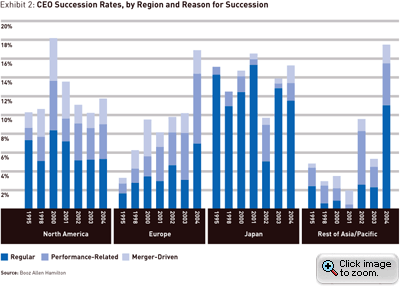
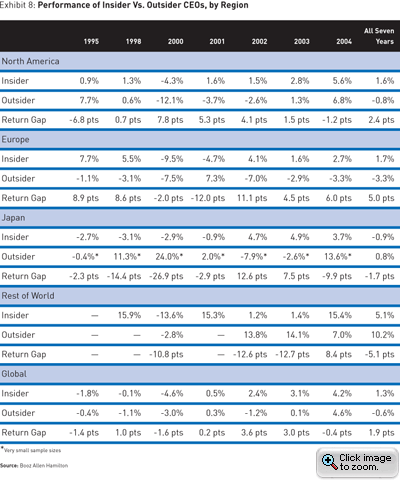
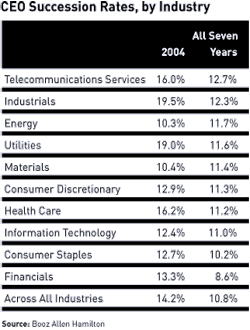 Industrial companies and utilities had the highest succession rates among the top 2,500 companies in 2004 (19.5 percent and 19 percent, respectively), followed by health care (16.2 percent) and telecommunications services (16 percent). The succession rates for industrials and utilities were the highest for these industries since we began our study. Together they make up only 19 percent of all companies, yet they accounted for 25 percent of all 2004 succession events — meaning that CEOs at industrials and utilities were 32 percent more likely to leave office in 2004. For the full seven years of data, telecommunications services, industrials, energy companies, and utilities had the highest succession rates; financial services had the lowest.
Industrial companies and utilities had the highest succession rates among the top 2,500 companies in 2004 (19.5 percent and 19 percent, respectively), followed by health care (16.2 percent) and telecommunications services (16 percent). The succession rates for industrials and utilities were the highest for these industries since we began our study. Together they make up only 19 percent of all companies, yet they accounted for 25 percent of all 2004 succession events — meaning that CEOs at industrials and utilities were 32 percent more likely to leave office in 2004. For the full seven years of data, telecommunications services, industrials, energy companies, and utilities had the highest succession rates; financial services had the lowest.